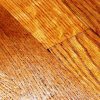So, you think that your can opener is clean? Think again.
1. Kitchen Sponges
Kitchen sponges are used to clean up any number of spills and often hold onto the bacteria they collect when cleaning. The safest way to rid your kitchen of harmful bacteria is to toss your kitchen sponge every two weeks or create a daily routine of tossing it into the dishwasher or heating it in the microwave for 30 seconds to kill any germs that might be growing. Even if your sponge looks clean or smells clean, it might be full of germs.
2. Cutting Boards
Whether you use a wooden board or a plastic board, cutting boards offer so many fine cuts to hide in that they are one of the favorite places for bacteria to hide and the one place where foodborne illness are often to blame. Simply wiping down or rinsing your cutting board won’t keep it clean like a food-safe disinfectant will. Get into the routine of disinfecting your cutting board with a store-bought product, or make your own by creating a paste of 1 tablespoon each baking soda, salt, water, and lemon juice. Scrub your board, rinse, and then dry well. If you are caring for a wooden board, be sure to wax it with a food-safe wax after to prevent warping.
3. Fridge
It is inevitable that the one place we store our food is the one place where we have the biggest hidden germs. Cold air, condensation, and food spills are the perfect recipe for unforeseen germs. Even a simple wipe down won’t keep them at bay; instead, use a solution of hot water and vinegar to wipe down your fridge weekly, paying special attention to drawers where meat and produce are kept. Or for an extra layer of defense, use shelf liners in your drawers, and run those through the dishwasher weekly for a spotless and germ-free fridge.
4. Small Appliances
Blenders, hand mixers, stand mixers, and all those wonderful small appliances that make our kitchen a foodies paradise may also be home to any number of germs. A simple wipe down when you are done just won’t keep the bacteria or dirt from taking up residence. The buildup of grease and food will not allow your kitchen disinfectant to work properly, so before you start, thoroughly clean your appliances by using an old toothbrush to get those hard to reach areas clean, and then use a spray disinfectant to penetrate those hard to reach areas. Dry thoroughly and give your lesser-used appliances quarterly clean to keep them dust-free.
5. Countertops
How many times have you placed your shopping bags on the counter this month? And then later prepared a meal on the same space? It may look clean, but deep down, the surface has more germs than you can imagine. Getting into a daily disinfectant routine before preparing a meal is the best defense against hidden bacteria resting on the surface of your countertops. For added precaution, allow your counters to air dry rather than wipe them clean with a dishcloth. And if you have a natural stone counter, sealing your counters on a regular basis will prevent those germs from penetrating the stone.
6. Can Openers and Hand Held Kitchen Tools
It is not every day that you look at your can opener and wonder how clean it is, but chances are, your can opener needs a good cleaning with a strong kitchen disinfectant. Bleach can be a bad word to some people, but a kitchen tool as hard-working and as intricate as a can opener needs a strong disinfectant. A solution of 1 part bleach to 2 parts water added to a spray bottle will clean away anything hidden that can cause foodborne illnesses. Simply spray down with your bleach solution, rinse, and then pat dry.
7. Kitchen Sink
We saved the worst offender for last because no matter how clean your kitchen sink may look, it can be sinfully dirty. The combination of food waste, water, and the drain combine together to create one of the best breeding grounds for E. coli in the kitchen. While your sink may be clean now, if you left your dishes to rest overnight, you need to give it a heavy cleaning in the morning. Household solutions like vinegar may stop some bacteria from spreading, but to properly clean your kitchen sink, use the strongest kitchen disinfectant that is safe for your sink.







You cannot use comments here, because comments are disabled for this page/post. Please enable page/post comment in settings.